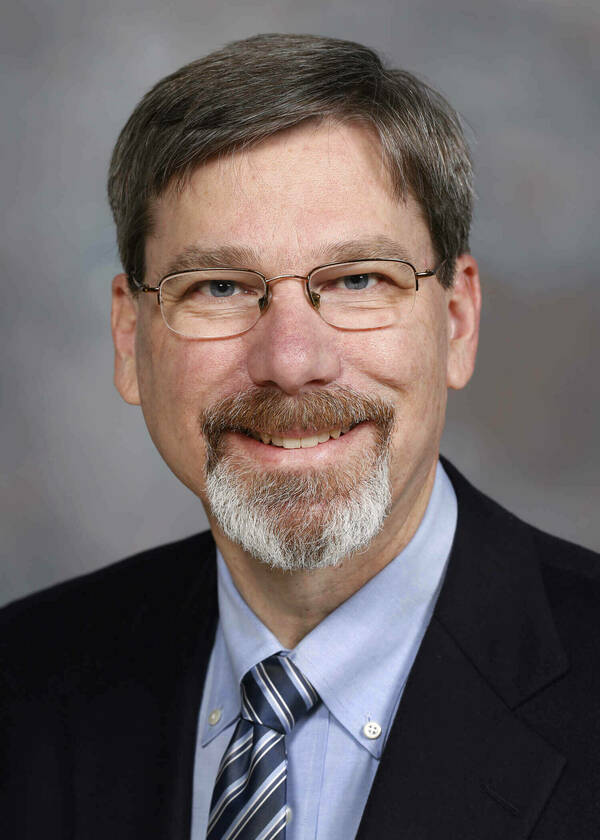
A mathematician and engineer with a long career at General Motors, who worked on issues as broad as battery life and industrial robots through use of mathematical algorithms, has been appointed as a research professor at the University of Notre Dame.
Charles W. Wampler II joins the faculty as the Huisking Foundation, Inc. Collegiate Research Professor. He holds a joint appointment in the Department of Applied and Computational Mathematics & Statistics (ACMS) in the College of Science and in the Department of Aerospace and Mechanical Engineering (AME) in the College of Engineering.
Wampler has had a long, fruitful relationship with several professors at Notre Dame. His first interaction was in 1990 with Andrew Sommese, now emeritus professor in ACMS. Their collaboration included significant work with several graduate students, including Jonathan Hauenstein, now professor and chair of the Department of ACMS. Wampler also worked with Mark Plecnik, now assistant professor in AME, when Plecnik was a graduate student in California. During his roles with Notre Dame, Wampler helped secure external funding from the National Science Foundation and the Air Force Office of Scientific Research.
“The people at Notre Dame—faculty, students, and staff—have all been uniformly a pleasure to work with,” Wampler said.
Wampler has been a member of the National Academy of Engineering since 2020, and he is a fellow of the American Society of Mechanical Engineers (ASME), the Institute of Electrical and Electronics Engineers (IEEE), and the Society of Industrial and Applied Mathematics (SIAM). He is also active in professional societies, having served on technical committees and editorial boards, including time as associate technical editor for the ASME Journal of Mechanical Design, Mechanism and Machine Theory, and the International Journal of Robotics Research.
“Dr. Wampler’s interests and expertise in modeling and real-time control algorithms are an exciting addition to our science and engineering programs at Notre Dame,” said Patricia J. Culligan, the Matthew H. McCloskey Dean of the College of Engineering. “I am thrilled that he is joining us as a senior joint hire across the Colleges of Science and Engineering.”
Linear algebra, which is ubiquitous throughout engineering, encompasses points, lines, planes and higher dimensional linear spaces, Wampler described. Algebraic geometry broadens the scope to treat a variety of nonlinear, curved objects like spheres, cylinders, and more complicated shapes. A typical application presents these objects abstractly as a system of equations to solve.
“To me, when a lengthy computation finally reveals the geometric structure encoded by the equations, it’s like bringing a telescope into sharp focus and understanding the universe of the problem at hand,” Wampler said.
He became interested in the topic because of questions arising in robotics and kinematics, which is the geometry of motion.
“Want to know how many ways the hand of a robot arm can reach a target? Since joints rotate in circles, you’ll find the answer in algebraic geometry,” he described. One of his favorite applications of the mathematics was in the design of Robonaut 2 (R2), a joint project between General Motors and NASA. R2 launched to the International Space Station on the final flight of Space Shuttle Discovery in 2011.
Wampler received his bachelor’s degree from the Massachusetts Institute of Technology (MIT) with a degree in mechanical engineering, and he earned his master’s and doctoral degrees from Stanford University. He began work at General Motors in 1985 and retired from his final role as senior technical fellow in June 2023.
He has published two books and more than 100 articles, and he holds 46 patents. His work ranges from human-vehicle interaction, to humanoid robotics, to battery capacity estimation for electric vehicles.
In addition to research and student mentoring roles, Wampler will also help mentor faculty in the Colleges of Science and Engineering, Hauenstein said.
"Dr. Wampler is an exceptional mathematical and engineering scientist recognized for his leadership in robotic systems in manufacturing, mathematical methods for robot motion and machine design, and traction battery modeling. He is joining our faculty to continue cementing his collaborations with our science and engineering faculty," said Santiago Schnell, the William K. Warren Foundation Dean of the College of Science. “Not only is he a world-renowned scholar, Dr. Wampler will serve as a role model and inspiration for our students."
At General Motors, Wampler led a number of initiatives related to advanced manufacturing systems. He significantly advanced the field of mechanism design and analysis, including polynomial homotopy continuation methods in mathematics. He and Sommese coined the phrase “Numerical Algebraic Geometry” in a 1995 conference paper, revolutionizing the field.
“This new position is a natural evolution of my career, another step in my long-term association with Notre Dame. While I enjoyed working in industry for more than three decades, this seems like a good time to concentrate on applied mathematics research,” Wampler said. “Beyond that, I very much look forward to working with colleagues at Notre Dame to advance research, to strengthen connections between the ACMS and AME departments, to guide students, and to engage with the international research community.”
Originally published by at science.nd.edu on August 14, 2023.